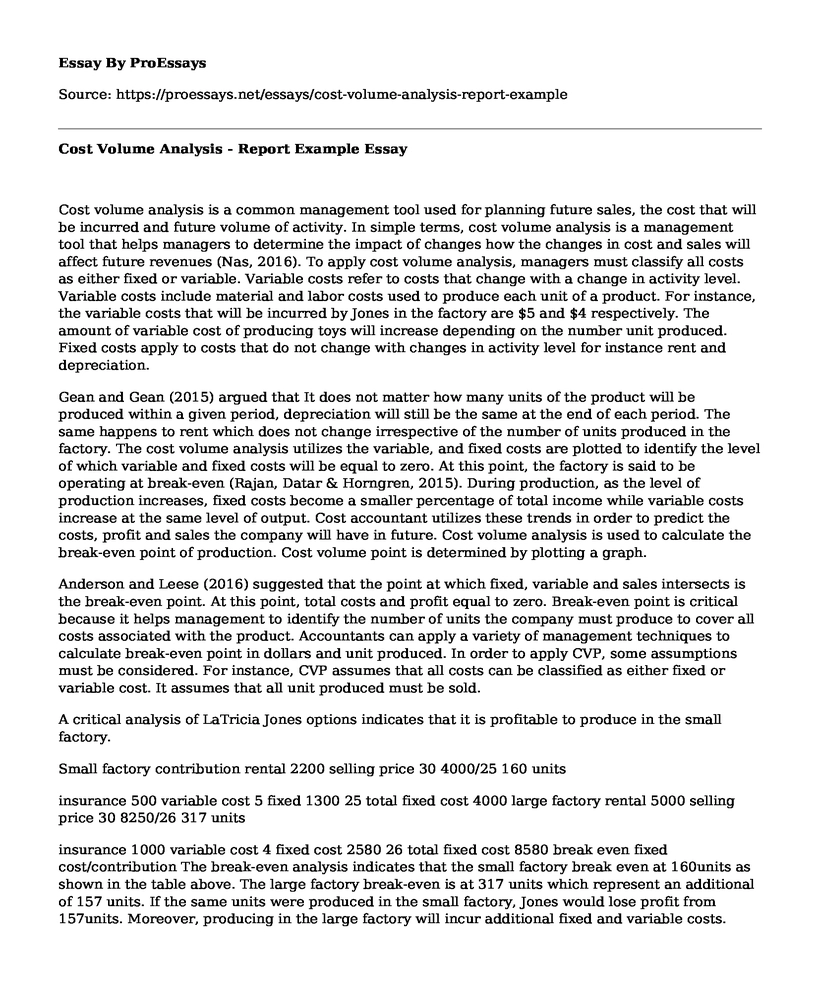Cost volume analysis is a common management tool used for planning future sales, the cost that will be incurred and future volume of activity. In simple terms, cost volume analysis is a management tool that helps managers to determine the impact of changes how the changes in cost and sales will affect future revenues (Nas, 2016). To apply cost volume analysis, managers must classify all costs as either fixed or variable. Variable costs refer to costs that change with a change in activity level. Variable costs include material and labor costs used to produce each unit of a product. For instance, the variable costs that will be incurred by Jones in the factory are $5 and $4 respectively. The amount of variable cost of producing toys will increase depending on the number unit produced. Fixed costs apply to costs that do not change with changes in activity level for instance rent and depreciation.
Gean and Gean (2015) argued that It does not matter how many units of the product will be produced within a given period, depreciation will still be the same at the end of each period. The same happens to rent which does not change irrespective of the number of units produced in the factory. The cost volume analysis utilizes the variable, and fixed costs are plotted to identify the level of which variable and fixed costs will be equal to zero. At this point, the factory is said to be operating at break-even (Rajan, Datar & Horngren, 2015). During production, as the level of production increases, fixed costs become a smaller percentage of total income while variable costs increase at the same level of output. Cost accountant utilizes these trends in order to predict the costs, profit and sales the company will have in future. Cost volume analysis is used to calculate the break-even point of production. Cost volume point is determined by plotting a graph.
Anderson and Leese (2016) suggested that the point at which fixed, variable and sales intersects is the break-even point. At this point, total costs and profit equal to zero. Break-even point is critical because it helps management to identify the number of units the company must produce to cover all costs associated with the product. Accountants can apply a variety of management techniques to calculate break-even point in dollars and unit produced. In order to apply CVP, some assumptions must be considered. For instance, CVP assumes that all costs can be classified as either fixed or variable cost. It assumes that all unit produced must be sold.
A critical analysis of LaTricia Jones options indicates that it is profitable to produce in the small factory.
Small factory contribution rental 2200 selling price 30 4000/25 160 units
insurance 500 variable cost 5 fixed 1300 25 total fixed cost 4000 large factory rental 5000 selling price 30 8250/26 317 units
insurance 1000 variable cost 4 fixed cost 2580 26 total fixed cost 8580 break even fixed cost/contribution The break-even analysis indicates that the small factory break even at 160units as shown in the table above. The large factory break-even is at 317 units which represent an additional of 157 units. If the same units were produced in the small factory, Jones would lose profit from 157units. Moreover, producing in the large factory will incur additional fixed and variable costs. Therefore, it is recommended that Jones should produce the toy in the small factory because it will generate more revenues that the large factory.
References
Anderson, J. A., & Leese, W. R. (2016). A Formula For The Units To Satisfy An Operation's Desired Rate Of Return In CVP Analysis-A Conceptual Approach. American Journal of Business Education, 9(2), 87.
Gean, F., & Gean, V. (2015). The Desirability of an Integrated Learning Methodology for Enriching CVP Analysis. Journal of Business and Accounting, 8(1), 127.
Nas, T. F. (2016). Cost-benefit analysis: Theory and application. Lexington Books.
Rajan, M., Datar, S. M., & Horngren, C. T. (2015). Cost Accounting. Pearson Higher Ed.
Cite this page
Cost Volume Analysis - Report Example. (2021, Jun 28). Retrieved from https://proessays.net/essays/cost-volume-analysis-report-example
If you are the original author of this essay and no longer wish to have it published on the ProEssays website, please click below to request its removal:
- Hospital Risk Management: A Case Study of Hospital for Special Surgery (HSS)
- Benchmark: Data Collection on Underperformance Problem Paper Example
- Impacts of Globalization and Technology on the Performance of Dunkin Donutsre
- Kingdom Holding Company Analysis Paper Example
- Essay Example on Leadership: A Crucial Concept for Everyday Life
- Essay Example on Scrum: Simple Framework for High Quality Product Development
- Improving Performance in Healthcare: Essential for Achieving Goals - Essay Sample







